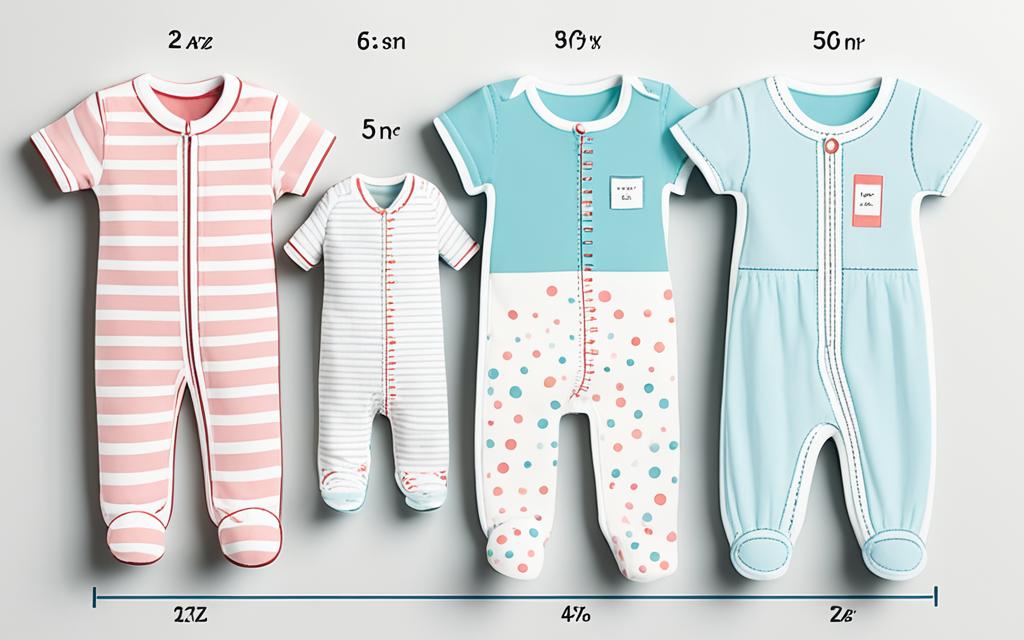Are you puzzled by the sizing system when it comes to baby clothes? Specifically, what size is 90 in baby clothes? We understand that finding the right fit for your little one can be a daunting task. That’s why we’re here to help! In this comprehensive guide, we’ll break down everything you need to know about baby clothing sizes, with a special focus on size 90. Say goodbye to confusion and hello to stress-free shopping!
Key Takeaways:
- Understanding baby clothing sizes is essential for a successful shopping experience.
- Size 90 may vary between brands and regions, so it’s important to decode its measurements.
- Consider both US and international size standards when choosing baby clothes.
- A baby clothing size conversion chart can help you navigate different sizing systems.
- Remember that fit goes beyond size labels, so take into account fabric, stretchability, and style.
Understanding Baby Clothing Sizes
Before we delve into the specifics of size 90 in baby clothes, it’s important to have a solid understanding of how baby clothing sizes work. Baby apparel sizing can vary depending on the brand or country, with sizes typically categorized by age or measurements.
“Choosing the right size for your little one can make a big difference in their comfort and overall enjoyment of their clothes.”
When it comes to baby apparel sizing, there are two common methods used:
1. Age-based sizing:
Many brands categorize their baby clothing sizes based on age, such as “0-3 months,” “3-6 months,” “6-9 months,” etc. This system provides a general estimation of the size range suitable for babies of different ages.
2. Measurement-based sizing:
Some brands and countries use measurement-based sizing to ensure a more accurate fit. This method involves using specific measurements, such as height, weight, and chest circumference, to determine the appropriate size for your baby.
Converting baby clothing sizes can be confusing, especially when shopping from different brands or countries. To help you navigate this process, we have compiled a baby clothing size conversion chart that will make it easier for you to find the right fit for your little one.
Baby Clothing Size Conversion Chart:
| Size | Age Range (Months) | Height (Inches) | Weight (Pounds) |
|---|---|---|---|
| 0-3 months | 0-3 | up to 24″ | up to 13 lbs |
| 3-6 months | 3-6 | 24-27″ | 13-17 lbs |
| 6-9 months | 6-9 | 27-29″ | 17-21 lbs |
| 9-12 months | 9-12 | 29-31″ | 21-25 lbs |
| 12-18 months | 12-18 | 31-34″ | 25-28 lbs |
Keep in mind that these measurements and sizes are approximate and can vary slightly from brand to brand. It’s always best to refer to the specific size chart provided by the brand you’re interested in.
Now that you have a better understanding of baby apparel sizing and conversion, you can confidently shop for the perfect size 90 clothing for your little one. In the next section, we will take a closer look at decoding size 90 in baby clothes and its corresponding measurements.
How to Measure Baby Clothing Sizes
When it comes to selecting baby clothes, finding the right size is essential for a comfortable fit. To ensure your baby looks adorable and feels cozy in their new outfits, it’s important to accurately measure their height, weight, and chest circumference. By following these simple steps, you can determine the perfect size for your little one:
- Height Measurement: Lay your baby flat on their back with their legs extended. Gently stretch a measuring tape from the top of their head to the bottom of their feet. Note down the measurement in inches or centimeters.
- Weight Measurement: Use a baby scale or check with your pediatrician to determine your baby’s weight. Be sure to record it in pounds or kilograms.
- Chest Circumference: Wrap a measuring tape around the widest part of your baby’s chest, just below the armpits. Make sure the tape is snug but not too tight. Record the measurement in inches or centimeters.
By taking accurate measurements of your baby, you can refer to size charts provided by different brands to select the appropriate size. Keep in mind that sizes may vary slightly between brands, so it’s essential to refer to specific measurements rather than relying solely on age ranges.
“Measuring your baby’s size ensures a comfortable fit and prevents any frustrations with ill-fitting clothes.”
Here’s an example of a baby clothing size measurement chart to give you an idea of how different sizes correlate with height, weight, and chest circumference:
| Size | Height (inches/cm) | Weight (lbs/kg) | Chest Circumference (inches/cm) |
|---|---|---|---|
| 0-3 months | Up to 23 inches (58 cm) | Up to 12 pounds (5.4 kg) | Up to 17.5 inches (44 cm) |
| 3-6 months | 23-26 inches (58-66 cm) | 12-16 pounds (5.4-7.3 kg) | 17.5-18.5 inches (44-47 cm) |
| 6-9 months | 26-29 inches (66-74 cm) | 16-20 pounds (7.3-9.1 kg) | 18.5-19.5 inches (47-50 cm) |
| 9-12 months | 29-31 inches (74-79 cm) | 20-24 pounds (9.1-10.9 kg) | 19.5-20 inches (50-51 cm) |
Remember:
- Measure your baby regularly as they grow to ensure their clothing remains a perfect fit.
- Consider the fabric and style of the clothes, as some materials may stretch or shrink over time. Refer to specific care instructions to maintain the garments’ integrity.
- Take note of any special sizing instructions provided by the brand to ensure accurate sizing.
By following these measurement guidelines, you can confidently select the right size of baby clothes, providing comfort and style for your little one.
Decoding Size 90 in Baby Clothes
Size 90 is a commonly used measurement in baby clothing, but it’s important to note that its actual measurements can vary depending on the brand and origin. To help you understand what size 90 typically corresponds to, we will break down its implications in terms of age range, height, weight, and other factors.
When it comes to baby clothes, sizing can be quite confusing, with different brands using different standards. Size 90 generally falls within the range of clothing designed for toddlers between 18 and 24 months. However, it’s always best to refer to the specific brand’s size chart for accurate measurements.
As a general guideline, let’s explore the approximate measurements associated with size 90:
| Measurement | Approximate Size 90 Correspondence |
|---|---|
| Height | 31-33 inches (78-84 cm) |
| Weight | 22-28 pounds (10-13 kg) |
| Chest Circumference | 19.5-20.5 inches (49.5-52 cm) |
Please note that these measurements are just approximations, and it’s essential to consider the specific proportions of your little one when selecting clothing in size 90. As babies grow at different rates, it’s crucial to regularly assess their measurements to ensure they are comfortable and properly dressed.
By understanding the basic guidelines for size 90 in baby clothes, you can shop with confidence, knowing that you’re choosing the right size for your little one’s needs.
Size 90 in Baby Clothing: US Standards
In the United States, baby clothing sizes adhere to a standardized chart. This chart ensures that parents can easily find the right size for their little ones. Knowing the US standards for size 90 in baby clothes can help you make informed choices while shopping.
Size 90 in baby clothing generally corresponds to infants aged 24 to 30 months. However, it’s important to keep in mind that sizes may vary slightly between brands. By referring to the US size chart, you can determine if your child falls within the recommended measurements for size 90.
Here is a breakdown of the general measurements associated with size 90 in baby clothing:
| Age Range | Height (inches) | Weight (pounds) |
|---|---|---|
| 24-30 months | 35-38 | 26-29 |
When shopping for baby clothes in size 90, be sure to consider the individual child’s measurements as well. Every baby is unique, and variations in height and weight can influence the fit of clothing. It’s always a good idea to measure your child and compare their measurements to the size chart provided by the brand.
Remember, the size chart serves as a general guideline, but it’s essential to pay attention to the specific measurements and fit of the clothes you’re considering. Some brands may have slightly different standards, so it’s best to consult their size chart for accurate sizing information.
Size 90 in Baby Clothing: International Standards
When it comes to baby clothing sizes, it’s important to note that international sizing standards may differ from those in the United States. If you’re a global shopper or planning to purchase baby clothes from different countries, understanding the common size 90 measurements can be helpful. Let’s take a closer look at size 90 in baby clothing across various regions, including the UK, Europe, and Asia.
UK Baby Clothing Size 90
In the United Kingdom, baby clothing sizes are typically categorized by age, similar to the US. Size 90 in the UK generally corresponds to babies aged 12-18 months, but it’s always advisable to refer to specific brand size charts for accurate measurements. Remember, sizes may vary slightly between brands, so double-checking the measurements is essential.
European Baby Clothing Size 90
In Europe, baby clothing sizes are commonly determined by height in centimeters. Size 90 in European baby clothes typically indicates a height range of around 85-95 cm, depending on the brand. It’s important to consider your baby’s height when selecting the appropriate size, as it will ensure a better fit and comfort.
Asian Baby Clothing Size 90
Asia follows its own set of baby clothing size standards, including for size 90. Asian size 90 generally corresponds to babies aged 18-24 months, with height considerations similar to other regions. However, as with any sizing system, variations may exist among different brands and countries, so referring to size charts specific to the brand you’re interested in is crucial.
| Country/Region | Age Range | Height Range | Additional Notes |
|---|---|---|---|
| United Kingdom | 12-18 months | – | Depends on specific brand size charts |
| Europe | – | 85-95 cm | Measurements vary by brand |
| Asia | 18-24 months | – | Refer to brand-specific size charts |
International Shopping Tips
When shopping for baby clothes internationally, it’s crucial to consider the sizing standards of the country or region you’re purchasing from. Always refer to brand size charts, as they offer more accurate measurements and size conversions. Additionally, pay attention to any specific sizing notes provided by the brand, as some countries may have their own unique sizing systems.
By understanding the variations in size 90 measurements across different countries, you can make more informed decisions when selecting baby clothes from around the world. Whether you’re looking for stylish outfits from European designers or exploring baby clothing options from Asian brands, being aware of international sizing standards ensures a better fit for your little one.
Tips for Buying Size 90 Baby Clothes
When it comes to buying baby clothes, navigating the world of size 90 can be overwhelming. To ensure a successful shopping experience that meets your baby’s needs, here are some practical tips and considerations to keep in mind:
Know your baby’s measurements:
Before making a purchase, it’s essential to have accurate measurements of your baby’s height, weight, and chest circumference. These measurements will help you choose the right size 90 in baby clothes and ensure a proper fit.
Refer to the size guide:
Each brand may have its own size guide, so make sure to check the specific measurements provided by the manufacturer. This will help you determine if size 90 in that brand aligns with your baby’s measurements.
Consider your baby’s growth:
Babies grow quickly, so it’s important to think about whether your little one might outgrow size 90 soon. If your baby is close to the upper limit of size 90 measurements, you may want to consider buying a size up to allow for growth.
Look for adjustable features:
Some baby clothes in size 90 come with adjustable waistbands, straps, or cuffs. These features can provide a more customized fit and extend the lifespan of the garment as your baby grows.
Opt for comfortable fabrics:
Babies have delicate skin, so prioritize soft, breathable fabrics like cotton or bamboo. These materials are gentle, hypoallergenic, and ensure maximum comfort for your little one.
Check for safety features:
It’s crucial to ensure that the baby clothes you purchase have appropriate safety features, such as secure snaps, buttons, or zippers. Avoid clothing with small embellishments or loose parts that could pose a choking hazard.
Read reviews and recommendations:
Before making a final decision, take the time to read reviews from other parents or seek recommendations from family and friends. Their experiences can offer valuable insights and help you make an informed buying choice.
Remember, every baby is unique, and finding the right size 90 baby clothes involves considering various factors such as brand, fit preference, and growth patterns. By keeping these tips in mind, you can make confident purchases that ensure your baby looks adorable and feels comfortable in their new clothes.
Stay tuned for the next section, where we’ll explore the differences between size 90 in baby clothing and toddler size 90, helping you understand the transition as your little one grows.
Size 90 vs. Toddler Size: What’s the Difference?
As your baby grows, you may find yourself wondering about the transition from baby sizes to toddler sizes. Specifically, what’s the difference between size 90 in baby clothing and size 90 in toddler clothing? Let’s explore and help you make informed choices.
Understanding Size 90 in Baby Clothing
Size 90 in baby clothing refers to the age range or measurements that correspond to this specific size. However, it’s important to note that the exact measurements can vary between brands and regions. Generally, size 90 in baby clothing is suitable for toddlers who are around 2 to 3 years old.
Exploring Toddler Size 90 Clothing
Toddler size 90 clothing is designed to fit children who have transitioned from baby sizes but are not yet ready for standard toddler sizes. These clothes are tailored for toddlers who are typically around 2 to 3 years old. Toddler size 90 clothing provides a comfortable and appropriate fit for this transitional stage.
To further understand the differences between size 90 in baby clothing and toddler size 90 clothing, let’s compare their typical measurements:
| Size | Average Age Range | Height Range | Weight Range |
|---|---|---|---|
| Size 90 in Baby Clothing | Around 2 to 3 years old | 82-92 cm (32-36 inches) | 11-15 kg (24-33 lbs) |
| Toddler Size 90 Clothing | Around 2 to 3 years old | 82-92 cm (32-36 inches) | 11-15 kg (24-33 lbs) |
As you can see, both size 90 in baby clothing and toddler size 90 clothing have similar measurements, emphasizing the overlap for children in this age range. It’s important to consider your child’s individual measurements and growth when selecting the appropriate size for them.

Remember, every child is unique, and these measurements are provided as general guidelines. It’s always a good idea to consult the specific size chart provided by the brand you’re considering and consider your child’s body shape and proportions.
By understanding the difference between size 90 in baby clothing and toddler size 90 clothing, you can confidently choose the right fit for your growing child. Take into account their age, measurements, and individual needs to ensure they stay comfortable and stylish as they continue to explore the world.
Baby Clothing Size Conversion Chart
When it comes to shopping for baby clothes, understanding the sizing can be a bit confusing. Different brands and countries often have their own sizing systems, making it difficult to find the right fit for your little one. But don’t worry! We’ve got you covered with our comprehensive baby clothing size conversion chart.
With this chart, you’ll be able to easily convert between different sizing systems, ensuring that you can find the perfect fit for your baby. Whether you’re converting from US sizes to international sizes or vice versa, our chart will make the process a breeze.
Here’s a sneak peek of our baby clothing size conversion chart:
| US Size | UK Size | Europe Size | Asia Size |
|---|---|---|---|
| 0-3 months | 0-3 months | 60/66 | 70 |
| 3-6 months | 3-6 months | 66/68 | 80 |
| 6-9 months | 6-9 months | 68/74 | 90 |
| 9-12 months | 9-12 months | 74/80 | 100 |
This is just a small preview of our comprehensive chart. It includes sizes from 0-3 months up to 9-12 months, but we’ve got you covered for all the other sizes as well.
Whether you’re shopping online or in-store, our baby clothing size conversion chart will be your go-to reference for finding the perfect fit. No more guessing or ordering the wrong size – let our chart be your shopping companion.
Make sure to bookmark this page or print out the chart for easy access whenever you need it. Shopping for baby clothes has never been easier!
Finding the Right Fit: Beyond Size Labels
When it comes to buying baby clothes, the size labels can only tell you so much. Every baby is unique, and their clothing requirements go beyond a simple number. To ensure the perfect fit for your little one, take into consideration other factors that can affect their comfort and mobility.
Fabric Types
The choice of fabric plays a significant role in how well a garment fits your baby. Opt for soft and breathable materials like cotton, which are gentle on their delicate skin and allow for better air circulation. Avoid fabrics that are too stiff or rough, as they may cause discomfort or irritation.
Stretchability
Incorporating stretchy fabrics into your baby’s wardrobe can provide flexibility and ease of movement. Look for clothes that have a bit of elastane or spandex blended with the main fabric. This ensures a better fit and allows your little one to explore and play comfortably.
Garment Styles
The style of the garment can also impact how well it fits your baby. Consider their body shape and mobility when choosing between different styles like onesies, rompers, or two-piece sets. For active babies who love crawling or walking, options with an elastic waistband or adjustable straps can provide a snug fit and freedom of movement.
“The right fit goes beyond the size label. Take into account the fabric, stretchability, and style of the garment to ensure your baby’s comfort and mobility.”
Remember, every baby grows at their own pace, so it’s essential to prioritize their comfort rather than focusing solely on the recommended size. Take the time to try on different styles and brands, keeping in mind the unique needs and preferences of your little one.
By going beyond size labels and considering fabric types, stretchability, and garment styles, you can select baby clothes that provide optimal comfort and unrestricted movement for your little bundle of joy.

| Factors to Consider for the Right Fit | Tips |
|---|---|
| Fabric Types | Opt for soft and breathable materials like cotton. |
| Stretchability | Choose clothes with a bit of elastane or spandex for better flexibility. |
| Garment Styles | Select styles that suit your baby’s body shape and provide ease of movement. |
Cleaning and Care Tips for Baby Clothes
Taking care of your baby’s clothes is crucial for ensuring their longevity and maintaining proper hygiene. Proper cleaning and storage techniques can help keep your little one’s clothes in excellent condition, ready to be worn again and again. Here are some helpful tips to guide you in caring for your baby’s clothes:
1. Sort by Fabric and Care Instructions
Before washing your baby’s clothes, separate them based on fabric type and care instructions. This allows you to wash similar fabrics together, preventing damage or shrinkage. Be sure to read and follow the care labels on each garment for the best cleaning results.
2. Use Gentle Detergents
When laundering your baby’s clothes, opt for a mild, hypoallergenic detergent specifically formulated for sensitive skin. Avoid using fabric softeners or bleach as these can irritate your baby’s delicate skin. For tough stains, pre-treat them with a stain remover suitable for baby clothes.
3. Wash in Cold Water
To preserve the quality of baby clothes, wash them in cold water. This helps retain the fabric’s color and prevents shrinkage. Coldwater washing is also gentler on your baby’s clothes, keeping them soft and comfortable.
4. Air Dry or Use Low Heat
Avoid using high heat when drying your baby’s clothes to prevent damage to the fabric. Instead, air dry them by laying them flat or hanging them on a line. If you’re using a dryer, set it to low heat. This method helps maintain the shape and texture of the garments.
5. Iron with Caution
If ironing is necessary, always use the lowest heat setting and iron inside out to prevent direct heat contact with the fabric. Be careful around any delicate embellishments or prints that may be on the clothes.
6. Store Properly
When storing baby clothes that are no longer in use, make sure they are clean and completely dry to prevent mold or mildew growth. Fold them neatly and store them in a dry, well-ventilated area. Using storage bins or vacuum-sealed bags can help protect the clothes from dust and pests.
7. Don’t Forget Stain Remedies
Accidents happen, and stains are inevitable with babies. Keep a baby-safe stain remover or natural remedies like baking soda and white vinegar on hand to tackle any stubborn stains promptly.
Pro Tip: To keep track of stains and treat them efficiently, consider keeping a stain removal log. Note down the type of stain, the method used to remove it, and the effectiveness of the treatment. This helps you identify patterns and find the best stain removal approaches for specific types of stains.
By following these cleaning and care tips, you can ensure that your baby’s clothes maintain their quality, stay fresh, and provide comfort during every wear. With a little extra care, you can extend the life of these precious garments, ready to be passed down or treasured as keepsakes.
Conclusion
In conclusion, understanding baby clothing sizes, particularly size 90, empowers you to shop confidently for your little one. By using our guide and the provided size conversion chart, you’ll be able to find the perfect fit and style for your baby’s clothing needs.
Remember that baby clothing sizes can vary among brands and regions, so it’s essential to measure your baby’s height, weight, and chest circumference to ensure the right fit. Additionally, be aware of the size charts specific to your country, such as the US standards or international measurements.
When shopping for size 90 baby clothes, keep in mind the transitional phase between baby sizes and toddler sizes. Understanding the slight differences can help you make informed choices and ensure your little one stays comfortable as they grow.
Lastly, don’t solely rely on size labels. Consider other factors like fabric types, stretchability, and garment styles to ensure optimal comfort and mobility for your baby. Taking proper care of their clothes, including washing and storing them correctly, will also prolong their lifespan. With these tips in mind, you’re ready to find the perfect size 90 baby clothes that both you and your little one will love.
FAQ
What size is 90 in baby clothes?
Size 90 in baby clothes typically corresponds to a height range of 85-95 cm or around 2-3 years of age. However, it’s important to note that sizes may vary between brands, so always refer to specific size charts provided by the manufacturer.
How do I convert baby clothing sizes?
To convert baby clothing sizes, it’s helpful to refer to a size conversion chart. These charts provide measurements in different sizing systems, allowing you to find the corresponding size across various countries or brands.
How do I measure baby clothing sizes?
To measure your baby’s clothing size accurately, you can measure their height, weight, and chest circumference. Use a measuring tape and refer to size charts provided by the brand to determine the most suitable size for your baby.
How do I buy size 90 baby clothes?
When buying size 90 baby clothes, consider your baby’s measurements, style preferences, and the season. Check the size chart provided by the brand and consult customer reviews for insights on the item’s fit and quality.
What’s the difference between size 90 in baby and toddler clothing?
The difference between size 90 in baby and toddler clothing can vary depending on the brand. Typically, baby clothing size 90 refers to infants aged 2-3 years, while toddler clothing size 90 corresponds to children aged 18-24 months.
How do I maintain and care for baby clothes?
To maintain and care for baby clothes, follow the care instructions provided on the garment’s label. Wash baby clothes in mild detergent, use gentle cycles, and avoid exposing them to harsh chemicals or excessive heat that may damage the fabric.








